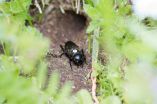Bold crickets have a shorter life
Differences in personality influence survival in field crickets
2015-04-23
(Press-News.org) This news release is available in German.
An individual's behaviour in risky situations is a distinct personality trait both in humans and animals that can have an immediate impact on longevity. Researchers from the Max Planck Institute for Ornithology in Seewiesen have now found differences in personality types for the first time in a population of free living field crickets. Risk-prone individuals showed a higher mortality as they stayed more often outside their burrow where they can be easily detected by predators, compared to risk averse individuals. Moreover, shy individuals are not encountered so often by researchers, causing potential bias in collected scientific data. This methodological problem has been a neglected in many personality studies but has been accounted for uniquely in the present study.
Animals, like humans, have distinct personalities that are partly defined by genes and partly shaped by the environment. Personality as a phenomenon means that some individuals are consistently more shy, bold, cautious or aggressive compared to others. During the last decade, different individual personality patterns have been detected in more than 100 animal species and found to be related to important life history traits such as reproductive success and survival.
Studying personality in the wild is important since it ensures that the behavioural expression as well as ecological data (such as longevity) are collected in a natural environment and thus not affected by artificial experimental setups used in the laboratory. Most studies of the relationships between personality and survival have been conducted on established vertebrate models such as mammals and songbirds and there are few studies, if any, on invertebrates in wild populations.
Scientists, led by Niels Dingemanse, from the Max Planck Institute for Ornithology in Seewiesen and the Ludwig-Maximilians-University in Munich have investigated the personality and survivorship in wild field crickets. Within a 120 m² fenced-off meadow, cricket nymphs were individually marked and monitored until they reached adulthood in order to study their individual behaviour and survival. For example, flight initiation distance, i.e. distance when crickets initiate the escape of an approaching thread, was determined by tapping a round wooden pole on the ground towards the cricket's burrow mimicking natural ground predators that prey on this insect. Together with the measurement of the maximum distance that crickets moved away from their burrows these behaviours were used to define whether crickets express personalities. As predicted, bold behaviours varied consistently between individuals, verifying the presence of personality.
Bold field crickets suffered from higher mortality compared to less bold ones probably because they are preyed upon by natural predators such as shrews and birds more often compared to shy individuals. Furthermore, bold individuals were more easily detected by the observer which likely represents the mechanism for their higher mortality: predators can detect bold individuals more easily. To verify that observers did not simply miss the shy individuals, the researchers fenced the burrows and repeated the measurements.
"These differences in the encounter rates between bold and shy individuals should be considered in future studies investigating relationships between personality and fitness in natural populations", says Petri Niemelä, first author of the study.
INFORMATION:
Original paper:
Petri T. Niemelä, Ella Z. Lattenkamp, Niels J. Dingemanse
Personality-related survival and sampling bias in wild cricket nymphs
Behavioral Ecology; advanced online publication 22 April, 2015
[Attachments] See images for this press release:

ELSE PRESS RELEASES FROM THIS DATE:
2015-04-23
Navigating through a cluttered environment at high speed is among the greatest challenges in biology - and it's one virtually all birds achieve with ease.
It's a feat David Williams hopes to understand.
A former post-doctoral fellow in the lab of Andrew Biewener, the Charles P. Lyman Professor of Biology, and a current post-doc at the University of Washington, Williams is the lead author of a study that shows birds use two highly stereotyped postures to avoid obstacles in flight. The study could open the door to new ways to program drones and other unmanned aerial ...
2015-04-23
This news release is available in German.
Researchers of Karlsruhe Institute of Technology (KIT) have unveiled an important step in the conversion of light into storable energy: Together with scientists of the Fritz Haber Institute in Berlin and the Aalto University in Helsinki/Finland, they studied the formation of so-called polarons in zinc oxide. The pseudoparticles travel through the photoactive material until they are converted into electrical or chemical energy at an interface. Their findings that are of relevance to photovoltaics among others are now published ...
2015-04-23
A Spanish-led team of European researchers at the University of Cambridge has created an electronic device so accurate that it can detect the charge of a single electron in less than one microsecond. It has been dubbed the 'gate sensor' and could be applied in quantum computers of the future to read information stored in the charge or spin of a single electron.
In the same Cambridge laboratory in the United Kingdom where the British physicist J.J. Thomson discovered the electron in 1897, European scientists have just developed a new ultra-sensitive electrical-charge sensor ...
2015-04-23
How long is the way from the city hall to the train station? When we estimate distances, something curious happens: short distances seem longer, and long distances shorter than they really are. Similar biases occur during judgments of volume, brightness or time. Psychologists call this phenomenon Vierordt's law. Its independence of the involved sensory systems suggests that our brain possesses universal principles for the assessment of physical quantities. However, where do the characteristic estimation biases stem from? In collaboration with colleagues from Zurich, neuroscientists ...
2015-04-23
It's a common dilemma faced by many working parents: your child has a cough or a cold, do you send them to nursery?
Researchers from the University of Bristol have, for the first time, investigated the process of decision-making that parents go through when faced with this situation. The research, published in The Journal of Public Health, reports that parents viewed coughs and colds as less serious and not as contagious as sickness and diarrhoea symptoms.
This resulted in many parents sending their child to daycare with a respiratory tract infection (RTI), which can ...
2015-04-23
In response to an article published by Chinese scientists describing research that used gene editing technologies in human embryos, the International Society for Stem Cell Research (ISSCR) has again called for a moratorium on attempts at human clinical germline genome editing while extensive scientific analysis of the potential risks is conducted, along with broad public discussion of the societal and ethical implications. The research article, entitled "CRISPR/Cas9-mediated Gene Editing in Human Tripronuclear Zygotes," was published online on April 18 in the scientific ...
2015-04-23
Imagine a day when scientists are able to alter the DNA of organisms in the lab in the search for answers to a host of questions. Or imagine a day when doctors treat genetic disorders by administering drugs designed to alter a patient's genome.
It may sound like science fiction, but with the development of genome-editing proteins like Cas9 and CRISPR, it could one day become science fact.
Before that happens, however, scientists must overcome a number of challenges, including how to improve the specificity of these proteins- the rate at which genome-editing proteins ...
2015-04-23
A more intellectually demanding job may be the key to living longer after developing young-onset dementia, according to health researchers.
Degeneration of the frontal and temporal parts of the brain leads to a common form of dementia affecting people under the age of 65. It results in changes in personality and behavior and problems with language, but does not affect memory.
"[Our] study suggests that having a higher occupational level protects the brain from some of the effects of this disease, allowing people to live longer after developing the disease," said Lauren ...
2015-04-23
An international team of scientists is calling for urgent and temperature patterns in mountain regions after compiling evidence that high elevations could be warming faster than previously thought.
Without substantially better information, people risk underestimating the severity of a number of already looming environmental challenges, including water shortages and the possible extinction of some alpine flora and fauna, according to the research team, which includes Henry Diaz and Imtiaz Rangwala from CIRES, the Cooperative Institute for Research in Environmental Sciences ...
2015-04-23
Shetland ponies' immune response to insect bites is helping scientists understand how people could be prevented from developing allergies.
The horse immune system can respond to midge bites in a way that prevents - rather than triggers - allergic reactions, researchers say.
The ponies' immune response to midge bites is similar to what happens in people with allergies, the team says. Understanding what triggers allergic reactions could help researchers come up with ways to stop people developing sensitivities.
It was previously thought that ponies which do not suffer ...
LAST 30 PRESS RELEASES:
[Press-News.org] Bold crickets have a shorter life
Differences in personality influence survival in field crickets




